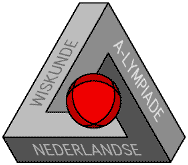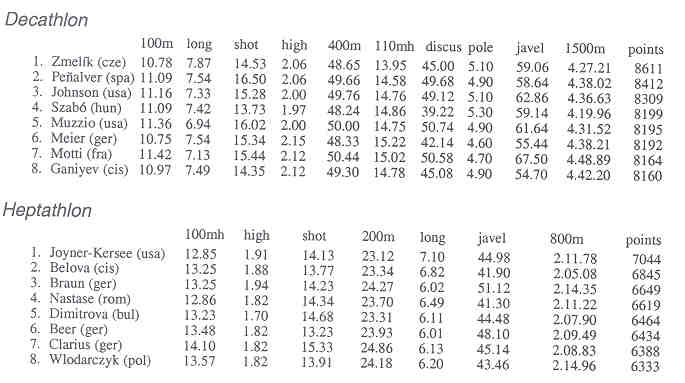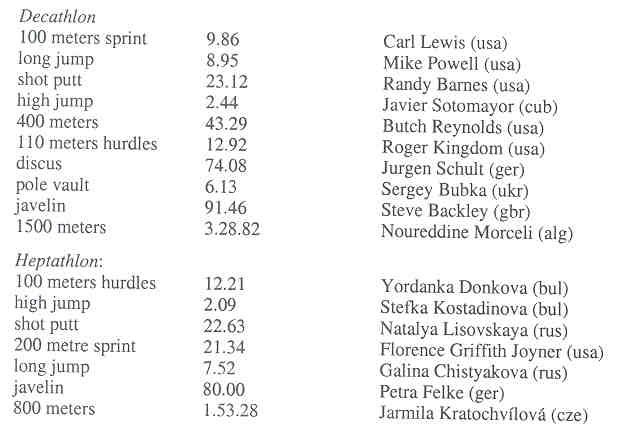 Math A-lympiad: Final
1993-1994
Math A-lympiad: Final
1993-1994
Decathlon and heptathlon
In this exercise the participants can use the book ‘IAAF. Scoring tables for
men’s and women’s combined events competitions’. (This book will be referred
to as “yellow booklet”).
Introduction
In important athletic competitions such as world championships and the Olympic
Games, many people wonder how the scoring is done in the decathlon for men and
the heptathlon for women (see appendix 1). Most questions relate to the way
in which performances in the various components of such a combined event (see
appendix 1) are converted into points. There is therefore a need for an article
to describe this clearly. In addition, such an article would provide a good
opportunity to examine further a number of aspects of combined events and to
examine possible variations. Such an article must satisfy a number of conditions.
General preconditions
- The article must be easy to follow for an interested layman.
- In order to increase the attractiveness of the article it must consist of
more than just text. Charts can thus contribute here.
- In addition to the article, appendices, charts or text may also be given
to give more detailed information to people who have more detailed questions.
Specific preconditions
- Facts
- A part of the article must deal with the history of the scoring, in particular
the premises of Ulbricht (see appendix 2) and progressive and regressive performance
tables/graphs (see yellow booklet, page 6).
- There must be explanation on the tables that are currently used (see yellow
booklet).
- Considerations with regard to the facts
- The tables currently used must be held up to the light in a critical way.
The results of the 1992 Olympic Games can be used as an example for the arguments
and reasoning (see appendix 3).
- The all-round nature and/or extent of the decathlon must be considered.
The world records in the individual events can be used in this respect (see
appendix 4). Examine the all-round nature of the heptathlon in the same way.
Are the winners real all-rounders or rather specialists in a certain section?
- The difference between the decathlon and the heptathlon, or the difference
between the performances of men and women must be considered.
- The modern decathlon mainly consists of explosive events. Exceptions are
the 400 metres (a kind of extended sprint) and the 1500 metres in particular.
Do these events occupy a separate place with regard to performance? How does
this point relate to the heptathlon?
- A few questions which lend themselves to examination, the results of
which can also be included in the article
- The best decathlete at this moment, the American Dan O’Brien, missed the
last Olympic Games, because he failed at his starting height in the pole vault
in the American selection competitions. (The athletes themselves specify their
starting heights. If you start too low then you have to jump more often and
that costs energy.) With sports such as sailing the worst performance can
be left out of consideration. This would have saved O’Brien. Is this a reasonable
proposal that must be studied further, or would this spoil the beauty of the
combined event? Would the results of the last Olympic Games change radically
here or not at all? The disadvantage is that in their training the decathletes
could just forget about a certain event that they find difficult. The risk
of that would be that a lower performance in another event would have to stand.
The condition for being able to drop an event is that all events “pay” the
same.
- Suppose that you are considering setting up a decathlon for pairs or threes.
Different versions can be considered here: every sportsman does all events
and the best result counts, or the events are divided equally (5-5 or 4-3-3).
Put a team together (from the participants of the last Olympic Games) that
would score the maximum. Can the Netherlands find a male duo or trio (see
appendix 5) that would get more points than Robert de Wit on his own (Robert
de Wit may not of course be in this team)?
- A possibility more or less related to this is to consider starting an international
combined event competition. A national team would then consist of two male
athletes and two female athletes. The article must formulate ideas about the
possible sporting content of such a combined event (which events and why)
and about a possible way in which the teams could be compared with one another
(points or otherwise, how to weight the performances of men and women).
Exercise
Write the article on the decathlon and the heptathlon that satisfies the general
preconditions given above and the conditions given under points 1 and 2. Furthermore
the article must deal with at least one of the questions given under point 3.
A choice can be made here depending on the available time.
Appendix 1
The male decathlon consists of ten athletic events completed over two days.
| Day 1: |
Day 2: |
| 100 meters sprint |
110 meters hurdles |
| Long jump |
Discus |
| Shot putt |
Pole vault |
| High jump |
Javelin |
| 400 meters |
1500 meters |
The female heptathlon consists of seven events held over two days.
| Day 1: |
Day 2: |
| 100 meters sprint |
Long jump |
| High jump |
Javelin |
| Shot putt |
800 meters |
| 200 meters sprint |
|
Appendix 2
Page 10 of the yellow booklet (last two paragraphs) contains a passage on the
premises of Ulbricht. This is freely reproduced here: With track events two
performances are chosen on the basis of statistical data. 0 points are given
to the lowest performance and 1000 points to the highest. The performances are
converted from time into speed and then there a linear distribution of points
is made between the lowest and highest speed. The speeds are then converted
into times to produce a table in which the times are linked to points. This
yields a progressive table (graph). With field events Ulbricht takes the starting
speed of the movement as the most important factor. This starting speed is converted
into a jump or a throw. Ulbricht assumes that the distance covered is proportional
to the square of the starting speed. A lowest and highest performance is selected
in the same way as above to which 0 and 1000 points are awarded respectively.
After that, the square root of the distance is taken and points are distributed
linearly. After that the square roots are converted into distances to yield
a table in which distances are linked to points. This yields a regressive table
(graph).
Appendix 3
The results of the decathlon and heptathlon from the 1992 Olympic Games are
given below.

Appendix 4
The world records (up to 1992 inclusive) in the various events are given below.
These world records are (generally) not achieved by decathletes and heptathletes
but by specialists in such events.

Appendix 5
Below are the best of season performances for 5 Dutch decathletes in 1992.

 Math A-lympiad: Final
1993-1994
Math A-lympiad: Final
1993-1994 Math A-lympiad: Final
1993-1994
Math A-lympiad: Final
1993-1994

